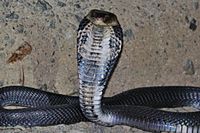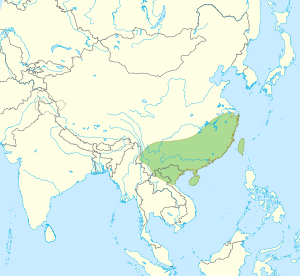Chinese cobra facts for kids
Quick facts for kids Chinese cobra |
|
|---|---|
 |
|
| Scientific classification | |
| Kingdom: | |
| Phylum: | |
| Class: | |
| Order: | |
| Suborder: | |
| Family: | |
| Genus: | |
| Species: |
N. atra
|
| Binomial name | |
| Naja atra Cantor, 1842
|
|
 |
|
| Range of the Chinese cobra | |
The Chinese cobra (Naja atra), also known as the Taiwan cobra, is a type of cobra. It belongs to the elapid family of snakes. You can mostly find this snake in southern China and some nearby countries and islands. It is one of the most common venomous snakes in Taiwan. Sometimes, it can bite humans.
Contents
About the Chinese Cobra's Name
The Chinese cobra was first described in 1842 by Theodore Edward Cantor. He was a Danish doctor, zoologist, and botanist.
The word naja comes from a Sanskrit word, nāgá. This word means "cobra." The word atra comes from Latin and means "dark" or "black."
In Mandarin Chinese, people call this snake Zhōnghuá yǎnjìngshé. This means "Chinese spectacled snake." It can also be called Zhōushān yǎnjìngshé, or "Zhoushan spectacled snake." In Guangdong and Hong Kong, it's known as fànchǎntóu, which means "rice paddle head."
The name "spectacled snake" comes from the markings on the back of its hood. These marks can look like eyeglasses.
What Does the Chinese Cobra Look Like?
The Chinese cobra is a medium-sized snake. It is usually about 1.2 to 1.5 meters (4 to 5 feet) long. Some rare ones can grow up to 2 meters (6.5 feet).
Its back is usually brown, gray, or black. It might have thin, light lines across its body. These lines are often clearer in young snakes. The snake's head is wide and slightly triangular. It is a bit different from its neck.
The scales on its back are smooth and shiny. This snake has a heavy body that can flatten when it feels threatened. It also has a short tail. Its nostrils are big and easy to see. The eyes are medium-sized with dark, dirty yellow irises and round, black pupils.
Like other elapid snakes, the Chinese cobra has fangs that always stand up. These fangs are at the front of its upper jaw. The top of its head is usually the same color as its body and tail. The sides of its head are lighter.
Sometimes, you might see cobras with white, yellow, or brown colors on their backs. They might also have white or light gray lines. The "spectacle" marking on its hood can look different on each snake. It can be a partial shape or an uneven pattern. The underside of its head and neck is white, light gray, or light orange. The underside of the hood might have two small dark spots followed by a dark band.
The color of the snake's belly and tail can vary. It might be white to gray, dark gray with white spots, or blackish. In Taiwan, cobras from the east are always blackish. Those from central and southern Taiwan are mostly white to gray. In northern Taiwan, you can find both blackish and white-gray cobras.
Where the Chinese Cobra Lives
This snake lives in southeastern People's Republic of China. This includes provinces like Sichuan, Fujian, Guangdong, and Hainan. It also lives in Hong Kong, northern Laos, northern Vietnam, and Taiwan. In Taiwan, it is much more common in the southern parts.
Where the Chinese Cobra Makes its Home
The Chinese cobra lives in many different places. These include woodlands, shrublands, grasslands, and mangroves. It can live in open fields, jungles, and even areas where many people live.
This snake is very good at adapting to different environments. It can be found in rice fields near the sea. It also lives in various types of mountain forests. However, it avoids dark forests with thick tree cover. In rainy seasons, it likes clearings and riverbanks in forests.
You can find more of these snakes near human homes. They also like secondary forests and rice fields next to forests. They live from sea level up to more than 2,000 meters (6,500 feet) high. They usually hide under leaves, sticks, and rocks.
How the Chinese Cobra Behaves
The Chinese cobra is very alert. It usually tries to get away from danger. But if it feels trapped, it will raise its front body. It will also spread its hood and strike if it needs to. Adult cobras can be quite aggressive. Younger cobras tend to be even more aggressive.
This snake usually tries to avoid people. But if it feels threatened, it will strike quickly. The Chinese cobra lives on the ground. It is active during the day and at twilight (dawn and dusk). People have seen it hunting during all daylight hours. It also hunts up to 2-3 hours after sunset from March to October. This happens when the temperature is between 20–32°C (68–90°F).
What the Chinese Cobra Eats
The Chinese cobra eats many different things. It mainly hunts rodents like mice and rats. It also eats frogs, toads, and even other snakes. It is active both day and night.
Young cobras mostly eat amphibians (like frogs). Adult cobras usually prefer reptiles and mammals. However, when amphibians are breeding, adult cobras eat mostly frogs or toads. Some of their favorite meals include the Cricket frog, the Common tree frog, and the Asian common toad.
How the Chinese Cobra Reproduces
The Chinese cobra lays eggs. This means it is an oviparous animal. They mate and lay eggs over a long period. Mating has been seen in the mountains of western Tonkin. This happens at heights of 400 to 2,000 meters (1,300 to 6,500 feet) from March to May.
Female cobras that are pregnant will lay between 6 and 23 eggs. This usually happens between May and the end of July.
Chinese Cobra Venom
The Chinese cobra is a very venomous snake. Its venom mainly contains special poisons called neurotoxins and cardiotoxins. These poisons can affect nerves and the heart.
If a Chinese cobra bites someone, the area around the bite can become dark, red, and swollen. It will also be painful and feel numb. Blisters and tissue damage (called necrosis) often happen. This tissue damage can be a serious problem and last for many years.
Other symptoms can also occur in the body. These include chest discomfort, fever, and a sore throat. People might have trouble swallowing or lose their voice. Their limbs might feel weak, and they might walk with difficulty. There can be general body aches, lockjaw, and trouble breathing.
Sometimes, a bite can be very dangerous. However, there is a special medicine called antivenom. It is widely available, and deaths from these bites are much rarer now than they used to be.
Images for kids
See also
 In Spanish: Cobra china para niños
In Spanish: Cobra china para niños




